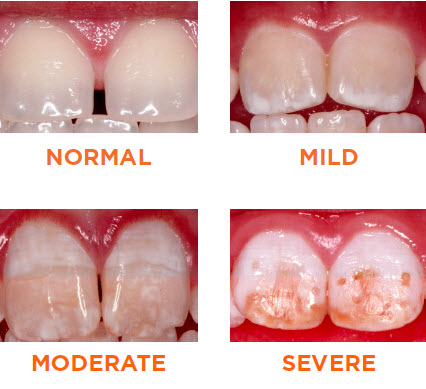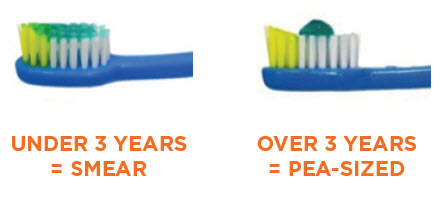Fluoride is an important mineral for all children. Our mouths contain bacteria that combine with sugars in the foods we eat and the beverages we drink. The acid that is produced harms tooth enamel and damages teeth. Fluoride protects the teeth and can even help reverse early signs of
decay. But the increased availability of fluoride today has resulted in more of something called dental fluorosis.
What is Dental Fluorosis?
 Dental fluorosis is a change in the appearance of the tooth's enamel surface. The most common types do not affect the function of the tooth and don't cause pain.
Dental fluorosis is a change in the appearance of the tooth's enamel surface. The most common types do not affect the function of the tooth and don't cause pain.
Most dental fluorosis is either very mild or mild. Mild forms of fluorosis appear as white, lacy markings on the tooth's enamel and are difficult to see with the untrained eye.
Fewer instances of fluorosis are categorized as moderate. Moderate fluorosis looks just like mild but covers more of the tooth.
In rare cases, fluorosis is described as severe. When fluorosis is severe, the enamel may have pitting and brown spots.
What Causes Dental Fluorosis?
Dental fluorosis is caused by consuming too much fluoride over the period of time when teeth are forming but before they appear in the mouth. This takes place before 8 years of age. To avoid this possibility, supervise brushing so that children do not use too much toothpaste, mouthwash, or mouthrinse and learn to spit, not swallow.
How Much Fluoride Should My Child Have to Protect His Teeth Without the Risk of Fluorosis?
Children who consume a typical diet, drink
fluoridated water, and use fluoridated dental products properly will get the fluoride they need for healthy teeth. It is not necessary to monitor water or food consumption since your child ingests low levels of fluoride from these sources. Parents will want to ensure that children do not swallow toothpaste or mouthrinse, which contain more concentrated amounts of this important mineral.
How Do I Know if My Child Has Dental Fluorosis?
Since there are many possible causes of changes in the appearance of the teeth, you may want to see a dental professional to have the teeth checked for fluorosis or other issues. The American Academy of Pediatrics recommends that all children begin regular visits to the dentist by their first birthday. Ask your pediatrician's office if they offer referrals.
Sources of Fluoride
Beverages, including fluoridated tap water
Foods processed with fluoridated water
Toothpaste and other oral care products
Topical fluoride & dietary supplements
How Do I Protect My Child's Teeth without Causing Fluorosis?
Here are three things you can do:
1.
Follow these guidelines on the proper use of dental products such as toothpaste. Children under the age of 6 should avoid the use of mouthwash and mouthrinse.
 Children younger than age 3 should use a "smear" of toothpaste containing fluoride.
Children younger than age 3 should use a "smear" of toothpaste containing fluoride.
Limit tooth brushing to 2 times a day for this age group.
Children aged 3-6 years should use a slightly larger, "pea-sized" amount of toothpaste containing fluoride.
Supervise and help young children with tooth brushing. Since most young children will instinctively swallow water, they should be encouraged to spit out excess toothpaste, but not rinse with water.
Keep all dental products out of the reach of young children to avoid accidental ingestion.
2.
Determine whether your primary source of water is fluoridated.
For information on local water systems see the CDC
My Water's Fluoride.
For information on well water, see
Private Well Water & Fluoride.
Most bottled water in the U.S. does not contain an optimal level of fluoride.
If your water is not fluoridated, speak to your child's doctor or dentist about ways to ensure your family is getting enough fluoride from other sources.
3.
Start regular visits to the dentist by your child's first birthday. If you do not have a dentist yet, your child's doctor can refer you to a dental home. He can also check her teeth, talk to you about taking care of her oral health, and make sure she is getting enough fluoride.
What about Infant Formula?
According to the American Dental Association, it is safe to
mix infant formula with fluoridated water.
Not All Sugars are Sweet!
Starchy foods, including snacks kids like such as pretzels, crackers, and chips, contain sugars, and sugar contributes to tooth decay!
Limit sweet and salty snacks, and offer water instead of sweetened beverages like soda pop and juice.
Additional Information: